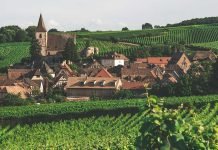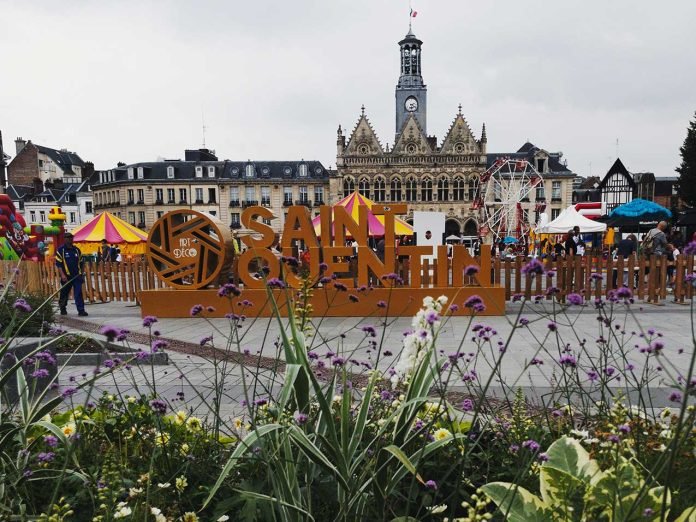Hauts-de-France, located in northern France, beckons visitors with a medley of enchanting vistas, robust culture, and compelling history. Offering an array of authentic experiences from the vibrant city life in Lille to the solemn remembrance of World War I battlefields, this region represents a unique blend of the past and the present. Here are ten highlights of Hauts-de-France that merit special attention.ED: Kevin Parker
- Lille’s colorful culture and historic architecture.
- Solemn World War I battlefields like Vimy and Somme.
- Breathtaking coastal landscapes of Opal Coast.
- Picturesque towns and villages such as Amiens, Saint-Quentin, and Le Cateau-Cambrésis.
- The stunning Cathedral Basilica of Our Lady of Amiens.
- A multitude of charming châteaux, including the Château de Chantilly and the Château de Pierrefonds.
- Unique natural wonders like the Marquenterre Bird Sanctuary.
- Two impressive National Parks: Scarpe-Escaut and Avesnois.
- A thriving food and wine scene, including Maroilles cheese and Champagne.
- Prestigious museums and galleries, including the Louvre-Lens Museum and the Matisse Museum.
Vibrant Cities and Historic Towns
Lille: A Cultural Tapestry
Lille, the capital of Hauts-de-France and the region’s largest city, is a thriving cultural hub where French chic meets Flemish influence. Its atmospheric old town, Vieux Lille, captivates with a maze of cobbled streets, lined with beautifully preserved 17th-century brick townhouses, vibrant café culture, and high-end boutiques. The lively Place du Général de Gaulle, commonly known as Grand Place, forms the heart of the city and is the perfect spot to admire Lille’s eclectic architectural styles, from the Flemish Renaissance to the neoclassical.
Imposing landmarks punctuate the cityscape. The Lille Cathedral, or Basilica of Notre Dame de la Treille, is a fascinating blend of traditional and modern architectural styles, while the Palais des Beaux-Arts de Lille, France’s second-largest fine arts museum after the Louvre, boasts an impressive collection of European paintings and sculptures.
Amiens and Beyond: A Journey through Time
Amiens, the capital of the Somme department, is particularly renowned for its Cathedral Basilica of Our Lady of Amiens. This UNESCO World Heritage Site is the largest Gothic cathedral in France and a marvel of medieval architecture, known for its intricately carved facades and stunning light and sound show, the Chroma, which illuminates the cathedral in its original polychrome colors.
Just as remarkable is the town of Saint-Quentin, where the Basilica of Saint Quentin, another exquisite example of Gothic architecture, dominates the skyline. Le Cateau-Cambrésis, the birthplace of Henri Matisse, pays homage to its native son through the Matisse Museum, featuring one of the world’s largest collections of the artist’s works. It is housed in the Fenelon Palace, an elegant mansion set within a beautiful park, combining art, history, and nature in a single visit.
Unraveling Natural Wonders
Opal Coast: Coastal Charm
The Opal Coast is a stunning natural gem of Hauts-de-France, stretching over 120 km from the Belgian border to the Bay of the Somme. It is characterized by its diverse landscapes, from expansive sandy beaches to rugged cliffs and sprawling dunes, offering a tranquil retreat to nature lovers. The Two Capes, Cap Blanc-Nez and Cap Gris-Nez, provide particularly breathtaking panoramic views of the English Channel.
The Green Belt: National Parks
Hauts-de-France is blessed with two beautiful national parks – the Scarpe-Escaut and the Avesnois. The Scarpe-Escaut, established as France’s first national park, is a diverse ecosystem of forests, marshlands, and pastures. It provides refuge for an array of flora and fauna, offering rich biodiversity. Similarly, the Avesnois National Park, known for its ‘bocage’ landscape – a patchwork of fields, hedgerows, and orchards – presents a tranquil, idyllic setting for a refreshing escape.
Marquenterre Bird Sanctuary: A Birdwatcher’s Paradise
The Marquenterre Bird Sanctuary, nestled in the heart of the Baie de Somme, is a mecca for birdwatchers and nature enthusiasts. Covering 250 hectares of dunes, forests, and marshlands, the sanctuary is a vital stopover for hundreds of species of migratory birds. Guided tours provide insight into these fascinating creatures in a unique environment that emphasizes respect for nature and biodiversity.
Indulging in the Local Cuisine
Hauts-de-France has a robust gastronomic tradition. From farm to table, the region takes pride in its local produce, best exemplified by the Maroilles cheese. This soft, washed-rind cheese, with a distinctive pungent aroma and a rich, creamy flavor, is a staple in many regional dishes. The region’s Flemish roots are apparent in its beer brewing tradition, with a variety of craft breweries offering a multitude of styles, from traditional blond and brown ales to innovative new flavors. Hauts-de-France also contributes to the iconic Champagne production with vineyards located in the south of the region.
Awe-inspiring Cultural and Historical Sites
Châteaux of Distinction
The Hauts-de-France region is graced with numerous elegant châteaux, each telling its own tale of the past. The Château de Chantilly, set amidst vast gardens and a serene lake, houses the Condé Museum, home to a remarkable collection of historical manuscripts and fine art. The Château de Pierrefonds, with its turreted walls and richly decorated interiors, appears straight out of a fairy tale and has served as the backdrop for numerous films and TV series.
Museums and Galleries Galore
Hauts-de-France’s commitment to preserving and celebrating art is evident in its numerous museums and galleries. The Louvre-Lens Museum, an avant-garde glass and aluminum structure, showcases rotating exhibits from the Paris Louvre’s vast collection. It represents an effort to decentralize France’s cultural treasures and make art more accessible to different regions.
Meanwhile, the Matisse Museum in Le Cateau-Cambrésis, situated in a stunning 18th-century mansion, presents an extensive collection of works by Henri Matisse. The museum provides a comprehensive look at the artist’s evolution, featuring his paintings, drawings, sculptures, and his famed paper cut-outs, attracting art lovers from around the globe.
A Region Steeped in History
World War I Battlefields: Echoes of the Past
The soil of Hauts-de-France holds deep imprints of World War I. The region saw some of the most grueling battles of the war, which have forever marked its landscape and people. Today, the battlefields of Vimy and the Somme offer powerful testimonies to this tumultuous past.
The Canadian National Vimy Memorial, standing on the site of the Battle of Vimy Ridge, honors the memory of Canadian soldiers who fought and gave their lives on French soil during the war. Its majestic twin pylons rise above the preserved trenches and shell craters, a stark reminder of the war’s reality.
The Somme battlefields are another major draw for history enthusiasts. Sites like the Thiepval Memorial, Beaumont-Hamel Newfoundland Memorial, and the Lochnagar Crater offer insightful glimpses into the Great War. Various museums, like the Historial de la Grande Guerre in Péronne, provide further context and understanding of the war’s profound impact.
Maritime Heritage: The Port Cities
Boulogne-sur-Mer
Boulogne-sur-Mer, a bustling seaside city, stands out for its strong maritime heritage. Known as France’s largest fishing port, the city takes pride in its sea-focused traditions, best experienced through the taste of local cuisine, enriched by the fresh catch of the day.
The city’s crowning jewel, however, is Nausicaá, the National Sea Centre. As Europe’s largest aquarium, it provides an immersive exploration of the marine world, with exhibitions housing a myriad of aquatic species, from colorful coral fish to graceful sharks.
Beyond its marine wonders, Boulogne-sur-Mer enchants visitors with its historic charm. The walled old town, ‘Ville Fortifiée,’ beckons with its charming cobbled streets leading up to the grand Basilica of Notre-Dame and the medieval castle, Château de Boulogne-sur-Mer, which houses an excellent museum showcasing art and artifacts from different eras.
Dunkirk: A City of Resilience
The coastal city of Dunkirk bears witness to a significant event in World War II history – the Dunkirk evacuation, or ‘Operation Dynamo.’ This remarkable military operation resulted in the rescue of more than 300,000 allied soldiers from the beaches around Dunkirk in 1940.
The Dunkirk War Museum, ‘Musée Dunkerque 1940 – Operation Dynamo,’ located in the fortifications that once protected the city, provides a comprehensive and emotive account of these events. The museum’s exhibits, including military equipment, photographs, and personal accounts, tell a poignant story of resilience and survival.
The modern port of Dunkirk, one of the largest in France, juxtaposes its historic past. It buzzes with energy, with container ships, ferries, and fishing boats navigating its waters daily.
Active Adventures
Cycling through the Countryside
The varied landscapes of Hauts-de-France, coupled with its excellent network of cycling routes, make it a paradise for biking enthusiasts. One of the popular trails is the Green Axis of the Artois, which cuts through the heart of the Artois area, passing through charming villages and fields filled with poppies.
The Somme Valley Circuit, another well-loved route, takes cyclists along the banks of the Somme River, through marshlands, and to notable WWI memorials. These routes not only provide a workout but also offer a unique way to explore the region’s countryside, heritage, and history.
Hiking the National Parks
For those who prefer to explore on foot, the National Parks of Scarpe-Escaut and Avesnois offer countless hiking opportunities. These parks, with their varied terrain and diverse ecosystems, cater to hikers of all levels. Whether it’s a leisurely stroll through the tranquil marshlands of Scarpe-Escaut or a challenging trek across the rolling hills of Avesnois, each trail offers its unique rewards.
Hauts-de-France’s Architectural Heritage
freedom and autonomy, dominate the region’s skyline. Many of these belfries, like the ones in Arras, Douai, and Amiens, are recognized as UNESCO World Heritage Sites and draw visitors for their grandeur and the panoramic views they offer from their summit.
Lille’s Old Stock Exchange: A Symbol of Prosperity
The Old Stock Exchange in Lille, known as ‘La Vieille Bourse,’ stands as an emblem of the city’s prosperous past. This architectural gem, located between the Grand’Place and the Place du Théâtre, is a beautiful example of Flemish Renaissance architecture. Composed of 24 houses organized around a cloistered courtyard, it is one of the most ornate buildings in the city.
Today, the courtyard serves as the stage for second-hand book stalls and various cultural events, lending it an atmosphere of vibrant conviviality. The surrounding area, with its bustling shops and cafés, adds to the lively spirit of the place.
Celebrations and Festivals: A Cultural Mosaic
Hauts-de-France has a rich tradition of hosting festivals and events that showcase the region’s vibrant culture and art. Among these, the annual Lille Braderie, the largest flea market in Europe, attracts crowds for its festive atmosphere, where haggling over antiques and collectibles is coupled with the tradition of eating mussels and fries.
The Dunkirk Carnival, with its colorful parades, lively music, and festive dances, is another event that encapsulates the region’s jovial spirit. On the other hand, the Amiens International Film Festival is a key event on the cinematic calendar, where filmmakers and enthusiasts come together to celebrate the art of filmmaking.
Hauts-de-France: A Commitment to Sustainability
Hauts-de-France is at the forefront of promoting sustainable tourism, driven by the understanding of its crucial role in preserving the region’s natural and cultural heritage. The region encourages eco-friendly travel practices such as cycling and walking over motorized transport.
Local cuisine emphasizes seasonal and local produce, promoting local gastronomy while reducing the carbon footprint. Energy-saving measures are implemented in public buildings, and efforts are made to conserve the region’s diverse natural habitats.
Visitors to Hauts-de-France not only enjoy its stunning landscapes, rich history, and vibrant culture, but also become a part of its commitment to a sustainable future.
Exploring Local Craftsmanship
The Lace of Calais and Caudry
The cities of Calais and Caudry in Hauts-de-France bear a long-standing tradition of lace-making. The International City of Lace and Fashion, situated in a renovated 19th-century lace factory in Calais, is a museum and research center dedicated to preserving and promoting the art of lace-making. Exhibits range from antique lace pieces and looms to contemporary lace designs, tracing the craft’s evolution.
In Caudry, the town’s Lace Museum continues the tradition of producing handmade bobbin lace, which gained international fame after being chosen for the wedding gown of Catherine, Duchess of Cambridge. Tours of the museum offer a glimpse into this intricate craft, emphasizing the skill and creativity involved.
Crystal Creation in Arques
Arques is home to Arc International, one of the world’s largest glassworks. A visit here provides a fascinating opportunity to observe the glass-making process from start to finish. From the transformation of raw materials into molten glass to the delicate shaping and refining of the finished product, the entire process is an artistic spectacle. The glassworks also houses a museum showcasing an array of fine glass and crystal creations, illuminating the history of glassmaking and its significance in the region.
The Literary Landscape
Hauts-de-France has inspired numerous authors and serves as the setting for several literary works. The Château de Montvillargenne in Chantilly, for instance, is believed to have inspired the fictional residence of Agatha Christie’s famous detective, Hercule Poirot. In Beauvais, the Maladrerie Saint-Lazare, a beautifully restored medieval leper colony, has featured as the backdrop for several historical novels, adding to the region’s literary allure.













